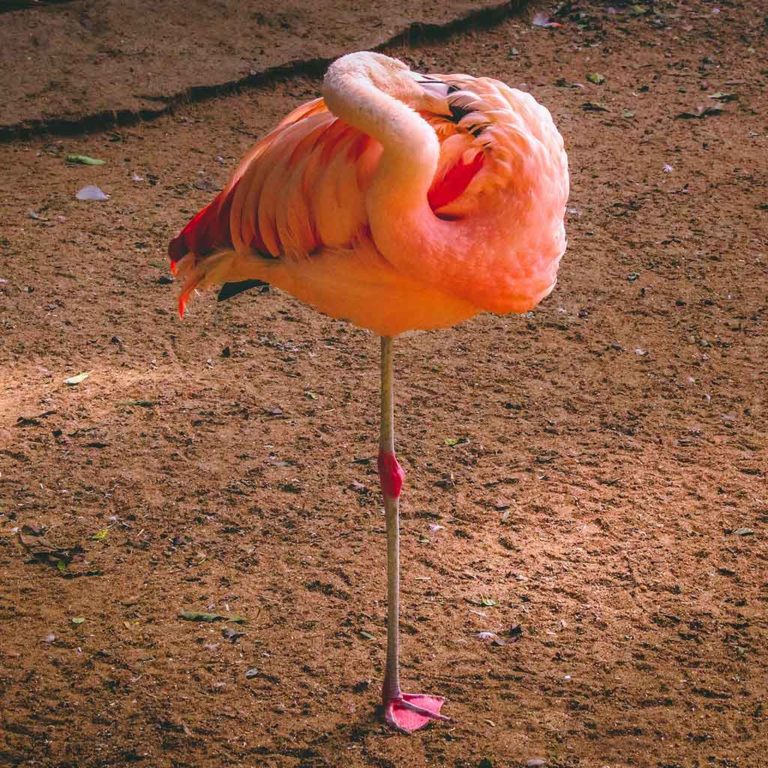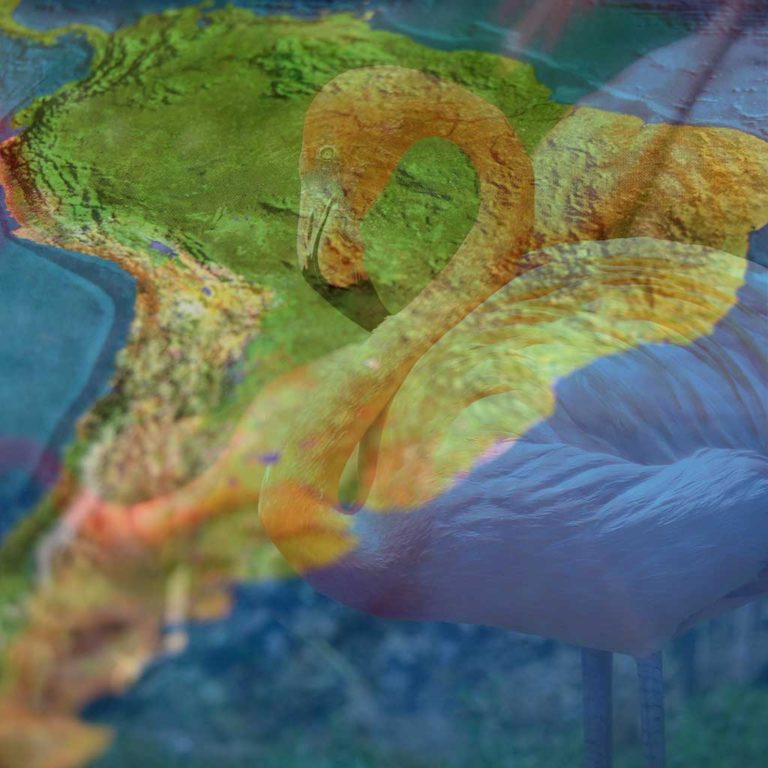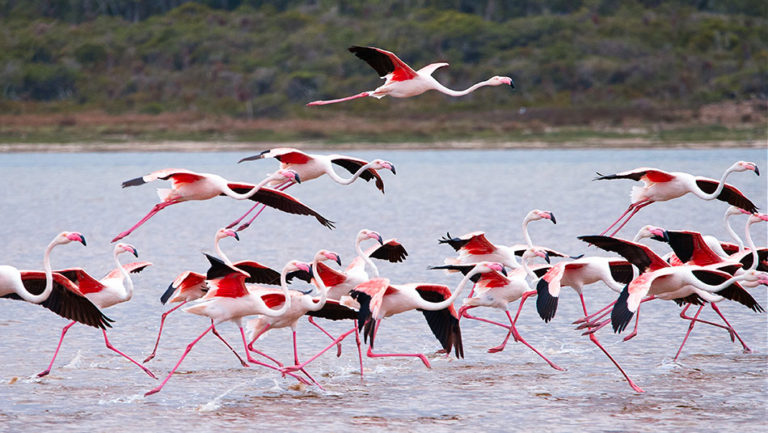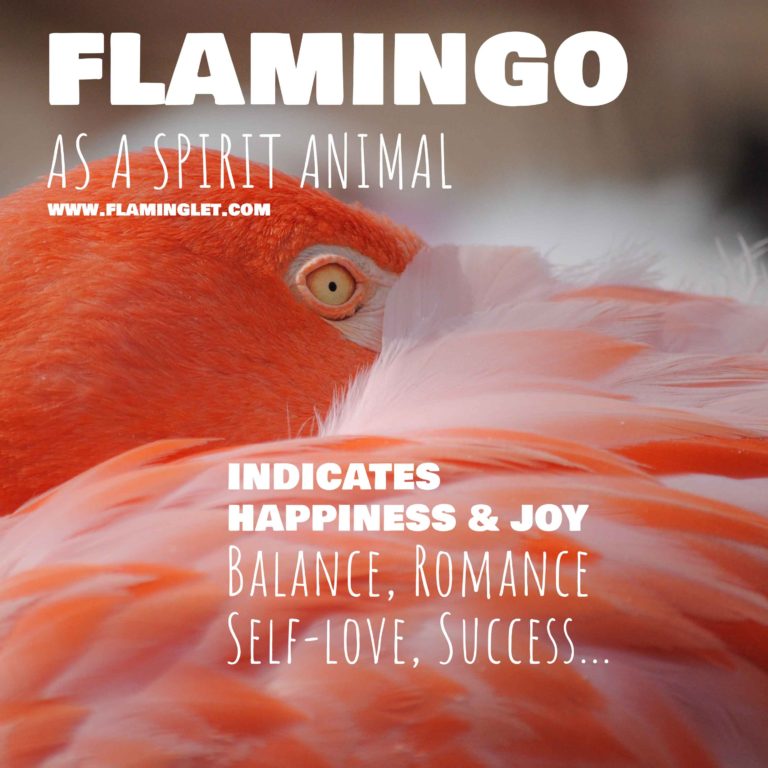Can Flamingos Swim? Or Do They Prefer Walking on Water?
We often see pictures of flamingos in a graceful upright position nearby water, but can flamingos swim?
Yes, flamingos can swim. Flamingos swim when their long feet do not reach anymore to the bottom. They use their webbed feet to peddle in the water when they are swimming.
Flamingos are water birds well adapted for wading and swimming when needed.
Why do flamingos swim?
The main reason for flamingos swimming seems to be that they transport themselves short distances within the water area to another more suitable location.
In some circumstances, flamingos need to get food from the deeper water than their feet can reach. In these situations, flamingos reach bottom mud by putting their heads underwater with tail up.
Flamingo with head underwater with long feet peddling looks quite funny, so we had to add this video here.
Do flamingos prefer wading or swimming?
Flamingos are known to be wading birds. They spend indeed more wading than swimming.
Flamingos long feet allow them to wade deeper in water than many other birds. Flamingos prefer to stand and walk on their webbed feet if the water is low enough, and they often choose shallow water areas to live. Large shallow lakes, mangrove swamps, tidal flats, and sea lagoon shores are their favorite living areas.
There may be a reason why flamingos prefer fading over swimming, even they are quite decent swimmers.
Flamingos’ primary method of finding food is wading around in low level waters and stomping with their feet on mud. Stomping stirs up mud and small creatures for eating. Then they scoop the mud and water with their beak and filter tiny creatures out of the mud.
So, flamingos are effective in stomping mud with their webbed feet. They find food easier and more effective this way than floating on water.
Can flamingo sleep on water?
Flamingos do not typically sleep while floating on water, but it is plausible. Flamingos float naturally, so napping while floating on water would be technically possible.
However, nearly always, flamingos prefer to sleep by standing on one foot.
Do flamingos bathe?
Yes, flamingos do bathe!
Bathing flamingo nearly always goes in water until its feet are halfway in the water and curls its feet under the body and starts splashing and cleaning itself with its beak.
Again, this is a wonderfully awkward sight, so we had to add this fun video here.
Can flamingos walk on water?
We hear this question surprisingly often.
Sorry to spoil all the fun but, flamingos can not walk on water.
Flamingos are relatively large animals and weight a few pounds. They do have large webbed feet, but not that huge that they could walk on water.
When flamingo is starting to fly from water, it is peddling with its feet fastly and same time flapping its wings. When flamingo’s wings begin to carry most of the weight of the bird, it looks like the bird is walking or running on top of the water for a few seconds.
Something similar happens when flamingos are landing on water. Flamingos ease up the landing with peddling with their feet.
Sneaky nature photographers have been taking photos of flamingos taking off with their camera set on fast shutter speed. They are capturing a few milliseconds of the movent to create an impression of stillness. In this kind of photos, it looks like flamingos are walking or running on water, but what is happening here is a lot of wing flapping and peddling with feet in real life.
Another illusion that makes an impression that flamingo is walking on water happens when flamingos are standing on shallow water. Our eye does not always capture the depth of wast waters around the bird correctly.
Can baby flamingos swim?
Yes, flamingo chicklets (or flaminglets) can swim after a few days they have been hatched.
Baby flamingos usually spend their first week or two in the nest and after they start to explore their surroundings by walking and swimming.
When flamingo chicklets are on the water, they float by nature and immediately start to do peddling movements and swim. Swimming helps flamingo chicklets to strengthen their fast-growing feet.
Can flamingos hold their breath?
Yes, flamingos can hold their breath, and they do it more often than we might first think.
When flamingos are eating, they are holding their breath while they insert their beak or whole head under water to scoop the mud to filter it for food.
Quite often, you see flamingos holding their heads underwater in search of food quite long times.
Do flamingos float, or do they sink if they don’t move in water?
Flamingos do not have to move to float or peddle while they are swimming on the water, they float.
Flamingos usually weight between 4-9 pounds, depending on the species and how large the individual is. Their feather cover is making them water repellent, so they don’t get wet and heavy like a rug and sink.
Flamingos are using their own preen gland oil to constantly groom their feathers. The preen gland is on the back of the bird, near the tail. This natural secretion oil helps to repel water from the feathers.
So, flamingo’s body, with well-groomed water repellent feathers, takes quite an amount of space, and yet flamingos are relatively lightweight creatures. The result of this structure is that flamingos’ buoyancy or upthrust in water is high, meaning that they float pretty well.
Can flamingos dive? Can flamingos go underwater?
Flamingos can be in shallow brief immersion without any problems, but they don’t precisely dive by being completely underwater.
Due to their structure, flamingos float exceptionally well, and they have difficulties to stay completely underwater. Flamingos can hold their breath, and they often float on the water keeping their heads underwater. But, one cannot call this really as diving.
Do flamingos see underwater?
We have seen underwater photos where flamingos are keeping their eyes open when their whole head is underwater.
Quite often, while finding food, flamingos are keeping their heads relatively long times underwater. During this period, they could also see and observe something underwater if the water is clear.
Many birds that live in close relation to water have been proven to have decent or even excellent underwater eyesight. We do not know for sure, but it does seem that flamingos do see underwater, and most likely better than humans.



